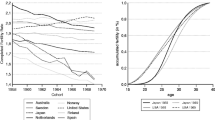Abstract
During the last fifty years there have in many countries been large movements in the growth of labor productivity, real wage rates, the rate of interest, and the household savings ratio. In this paper we use an overlapping generations model to study if demographic shocks, like the baby boom, can generate the kind of movements observed. Simulations show this is indeed the case. We also study the interactions between a pay-as-you-go pension system and demographic disturbances.
Similar content being viewed by others
References
Atkinson AB, Stiglitz JE (1980) Lectures on public economics. McGraw-Hill, New York
Auerbach AJ, Kotlikoff LJ (1985) Simulating alternative social security responses to the demographic transition. Nat Tax J 38:153–168
Auerbach AJ, Kotlikoff LJ, Hagemann RP, Nicletti G (1989) The economic dynamics of an ageing population: the case of four OECD countries. Discussion Paper Series No 172, Department of Economics, Boston University
Bentzel R, Berg L (1983) The role of demographic factors as a determinant of savings in Sweden. In: Modigliani M, Henning R (eds) Determinants of national saving and wealth. Macmillan, London, pp 152–179
Berg L (1988) Hushallens sparande och konsumtion. Stockholm: Allmanna Forlaget
Bloom DE, Freeman RB, Korenman SD (1987) The labor market consequences of generational crowding. Discussion Paper Series No 370, Department of Economics Columbia University
Davies J, Whalley J, Hamilton B (1989) Capital income taxation in a two-commodity life cycle model: the role of factor intensity and asset capitalization effect. J Public Econ 39:109–126
Diamond PA (1965) National debt in a neoclassical growth model. Am Econ Rev 55:1125–1150
Erixon L (1987) Profitability in Swedish manufacturing: trends and explanations. Almquist & Wiksell, Stockholm
Hausmann JA, Poterba JM (1987) Household behavior and the tax reform act of 1986. Econ Perspect 1:101–119
Horioka CY (1987) Why is Japan's private saving rate so high? In: Sato R, Negishi T (eds) Record developments in Japanese economics. Academic Press/Harcourt Brace Jovanovich, Tokyo, pp 145 -178
King M (1985) The economics of saving: a survey of recent contributions. In: Arrow K, Honkapohja S (eds) Frontiers of economics. Blackwell, Oxford, pp 227–294
Kotlikoff LJ (1989) What determines savings? MIT Press, Cambridge
Mankiw NC, Weil DN (1988) The baby boom, the baby bust, and the housing market. Working Paper No 2794, NBER
Samuelson PA (1958) An exact consumption-loan model of interest with or without the social contrivance of money. J Polit Econ 66:467–482
Samuelson PA (1975) Optimum social security in a life-cycle growth model. Int Econ Rev 16:539–544
Smith A (1982) Intergenerational transfers as social insurance. J Public Econ 19:97–106
Author information
Authors and Affiliations
Additional information
We are grateful to Laurence Ball, Alex Cukierman and two anonymous referees for helpful comments.
Rights and permissions
About this article
Cite this article
Blomquist, N.S., Wijkander, H. Fertility waves, aggregate savings and the rate of interest. J Popul Econ 7, 27–48 (1994). https://doi.org/10.1007/BF00160436
Received:
Accepted:
Issue Date:
DOI: https://doi.org/10.1007/BF00160436




